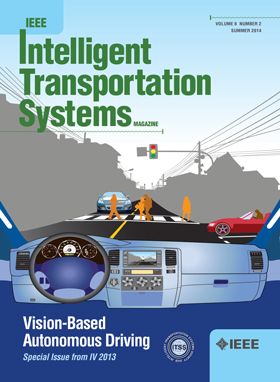Synergizing Autonomous and Traditional Vehicles: A Systematic Review of Advances and Challenges in Traffic Flow Management With Signalized Intersections
IF 7.9
1区 工程技术
Q1 ENGINEERING, CIVIL
IEEE Transactions on Intelligent Transportation Systems
Pub Date : 2024-09-06
DOI:10.1109/TITS.2024.3450471
引用次数: 0
Abstract
The advent of technology has led to substantial progress in the field of autonomous vehicles (AVs), indicating that AVs will become a generic mode of transport in the near future. However, there is a long journey ahead before we fully transition into an era dominated by AVs. Consequently, it is anticipated that traditional vehicles (TVs) and AVs will share the roadways in the coming years. AVs and TVs exhibit marked differences in aspects such as response time to signals and capability to share destination information. These differences suggest that traffic control policies designed exclusively for TVs may be substantially different from those suitable for a blend of AVs and TVs. To reconcile these disparities, the separation of lanes or roads for AVs and TVs could present a more effective strategy for traffic management. Moreover, the optimal traffic signal pattern at each intersection could depend on the AV-to-TV ratio. Through the implementation of an intelligent transportation system, the traffic control system can better manage mixed-flow scenarios for multi-intersection positions. This study defines a multi-intersection mixed traffic control problem (MIMTCP), in which both AVs and TVs pass through multiple signalized intersections. In addressing the MIMTCP, three primary subproblems were identified: traffic signal control, lane allocation, and trajectory planning. This paper offers a comprehensive review of the scholarly efforts directed at resolving these subproblems through the use of optimization algorithms, data-driven learning-based methodologies, and simulation-based approaches. Finally, we delve into promising research opportunities within each subproblem, with an emphasis on the development of strategic solutions and methodological approaches.自动驾驶车辆与传统车辆的协同作用:信号交叉口交通流管理的进展与挑战系统综述
技术的进步使自动驾驶汽车(AV)领域取得了长足的进步,这表明在不久的将来,自动驾驶汽车将成为一种通用的交通方式。然而,要完全过渡到由自动驾驶汽车主导的时代,还有很长的路要走。因此,预计在未来几年内,传统汽车(TV)和自动驾驶汽车(AV)将共享道路。AV 和 TV 在信号响应时间和共享目的地信息的能力等方面存在明显差异。这些差异表明,专为电视设计的交通管制政策可能与适合 AV 和电视混合使用的政策大相径庭。为了调和这些差异,将车道或道路划分为 AV 和 TV 专用可能是一种更有效的交通管理策略。此外,每个交叉路口的最佳交通信号模式可能取决于 AV 与 TV 的比例。通过实施智能交通系统,交通控制系统可以更好地管理多交叉口位置的混流场景。本研究定义了一个多交叉口混合交通控制问题(MIMTCP),在该问题中,自动驾驶汽车和电视都要通过多个信号交叉口。在解决 MIMTCP 问题时,确定了三个主要子问题:交通信号控制、车道分配和轨迹规划。本文全面回顾了学术界通过使用优化算法、基于数据驱动的学习方法和基于模拟的方法来解决这些子问题的努力。最后,我们深入探讨了每个子问题中具有前景的研究机会,重点关注战略解决方案和方法论途径的开发。
本文章由计算机程序翻译,如有差异,请以英文原文为准。
求助全文
约1分钟内获得全文
求助全文
来源期刊

IEEE Transactions on Intelligent Transportation Systems
工程技术-工程:电子与电气
CiteScore
14.80
自引率
12.90%
发文量
1872
审稿时长
7.5 months
期刊介绍:
The theoretical, experimental and operational aspects of electrical and electronics engineering and information technologies as applied to Intelligent Transportation Systems (ITS). Intelligent Transportation Systems are defined as those systems utilizing synergistic technologies and systems engineering concepts to develop and improve transportation systems of all kinds. The scope of this interdisciplinary activity includes the promotion, consolidation and coordination of ITS technical activities among IEEE entities, and providing a focus for cooperative activities, both internally and externally.
 求助内容:
求助内容: 应助结果提醒方式:
应助结果提醒方式:


